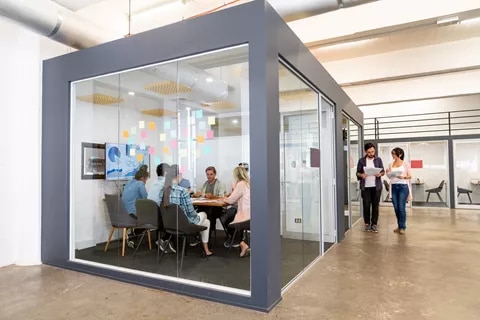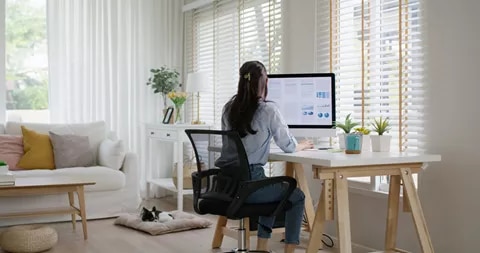The new normal of hybrid workspaces and remote work
In 2019, could you ever have imagined that your employer would request that you work from home permanently? Once office workers would crave a day to slow down and enjoy remote work as a break from all the hustle and bustle of office life. Now, as the world is forced to refocus on health and safety, telecommuting is creating a new kind of hybrid workspace where employees combine working from home with working on-site.
Teams can now stay connected with their colleagues and complete a day’s work all from the comfort of their home, thanks to telecommuting technologies like Zoom and Google Hangouts. Some enjoy doing their daily work tasks from their home office (or kitchen table). Some find the self-management requirements of remote work a far larger chore than heading into the office.
But just what exactly does this new hybrid workspace actually mean for the future of office spaces? Will organisations ever return to the ‘old way’ of working? Or will the circumstances we’ve become accustomed to in 2020 force organisations to move towards a new, improved and more practical way for people to work safely that combines the best of both worlds?
Why are hybrid workspaces becoming the ‘new normal’?
It’s taken a pandemic to unhinge the traditional office space from its dominant position in the workforce.
Months into the new normal, every organisation is in a different phase of reopening and making its workplace safe. And that means it’s hard to get a grasp on what the next weeks, months, and years will look like for the future of work.
However, hybrid workspaces are becoming more common as a way to effectively create a safer, more flexible work environment while keeping up with rapidly shifting health guidelines and personal wellbeing issues associated with coronavirus.
Australian businesses are now experimenting with new ways to deliver the benefits of in-person collaboration with the flexibility of working from home. It’s called a ‘hybrid’ approach because it allows staff to work at home on a routine basis while creating a rotating roster that enables teams to work in a physical office if they need to.
Essentially that means all traditional workplaces are becoming co-working spaces, allowing individuals to book a time to work in their own company’s premises interchanged with extended periods of working from home. And this new way of working brings with it a new approach to how we encourage people to do their best work, wherever they may be.

How will hybrid workspaces benefit my productivity?
The most significant benefit of the new hybrid workspace is that it encourages people to work together. It’s beginning to break down physical barriers between teams, pushing them to connect virtually with each other to stay on top of tasks and production schedules.
Switching up from working together in an office to remote work from home, means finding new and better ways of staying connected and up-to-date with each other’s progress through virtual offices and virtual meeting places.
But this doesn’t mean that productivity and collaboration necessarily suffers. In a physical office environment, the greatest innovations rarely come from a solitary worker in an enclosed cubicle but a diverse culture of collaboration—and achieving this has often required a significant shift in organisational culture and your workforce.
However, in one fell swoop, the coronavirus has necessitated an immediate shift to hybrid workspaces that push employees towards more successful collaborative efforts faster and requires they work in a more cohesive and interconnected way together despite physical separation.
How this plays out for the future of how we work is still being determined. But seismic shifts in the ways we do things often bring with them greater opportunities for innovation, if an organisation can manage the change effectively.
Adaptability for all teams within hybrid workspaces.
With so many Australian companies on a shared journey to find a successful hybrid workspace model, it might be tempting to plan your transformation around what other companies have done.
The problem with this strategy, however, is that every company will have different needs and expectations for their workplace.
To create a successful and cohesive hybrid remote working environment, you need to determine the workplace strategy that best benefits your business and your employees. How? Through thorough research and relying on reliable, measurable data about what your employees need to do their best work daily, including access to tools, technology and each other.
Often, a hybrid workspaces’ design aesthetics contribute much to worker adaptability and efficiency, encouraging greater communication and team bonding. Consider adding design elements such as atriums, shared workspaces in common areas, staircases with seating, and even outdoor workspaces to help foster a sense of unity, creativity and productivity amongst your staff. Locating desirable amenities in diverse locations around the office also facilitates ‘casual collisions’ throughout the workday to promote teamwork and increase collaborative potential.
Health and wellbeing concerns for hybrid workspaces.
The top four concerns for business’ reopening a physical office space are:
• Long-term/short-term financial situation
• Job security
• Physical health
• Mental health.
Hybrid workspaces allow organisations to reopen safely by restricting employee numbers and making it easier to clean the working environment and associated equipment. They also offer more flexibility for staff, increasing wellbeing at work and allowing time to focus on family and caregiving responsibilities in uncertain times.
They’re also particularly attractive for a new generation of workers. For instance, a recent report shows that 70% of Gen Z employees and 68% of Millennial workers have moderate concerns about their family or personal circumstances when it comes to returning to work, compared to 35% of Baby Boomers.
Moving your workplace to 100% online offers more options for those who need to care for family members and means employees have far more choice. They can choose how to work based on the option that offers the highest productivity – remote working, time working in a physical office, or some combination of the two. This added flexibility means more workers can organise a full or part-time transition to working from home so they can provide care while also earning in income.


Company benefits of transferring to a hybrid workspace.
The vital question to answer is, does your organisation want to transfer to a hybrid workspace permanently? Once the coronavirus pandemic is over, there’s a raft of benefits that might convince you this is the new future of work.
Underutilised corporate office space was a huge problem before COVID-19, and the pandemic has only further highlighted the staggering amount of money organisations might save by optimising their floorplate to ensure they’re maximising every inch.
Transitioning to a hybrid workspace could result in significant cost savings—and, for global organisations with workers spread across multiple sites, it couldn’t even save millions annually.
Smart organisations worldwide are re-investing a portion of the savings they’ve made from switching to remote work or telecommuting back into creating a hybrid workspace that perfectly suits their workers’ needs. Other savings can then go to improving the employee experiencing (increasing the ability to attract and retain staff more easily) or enhancing broader organisational strategies.
The era of purely physical organisations had begun to wane even before coronavirus. The crisis has only fast-tracked the move towards digital transformation and highlighted just how central the new hybrid workspace is to creating a successful, agile and future-proofed business model.





